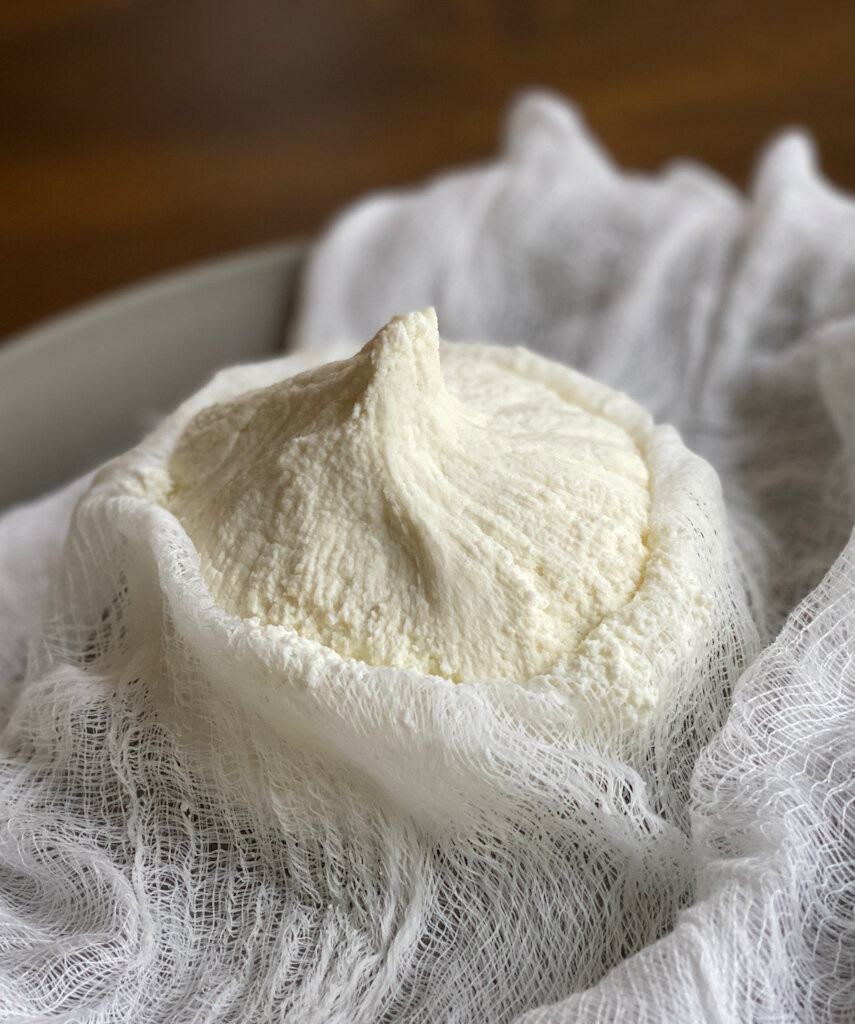Paneer (Fresh Indian Cheese)
It’s remarkably easy — and immensely gratifying — to make home-made paneer, the fresh farmer-style cheese that Maneet Chauhan and Jody Eddy describe as “virtually the only cheese consumed in India.” This recipe is adapted from one in their book Chaat: Recipes from the Kitchens, Markets and Railways of India.
Read our November 2020 review of Chaat: Recipes from the Kitchen, Markets and Railways of India.
The whole process, which involves only whole milk, lemons and kosher salt, is achieved in about an hour. Soft, tender, a little crumbly, with a fresh, lightly salty tang, the result is a hundred times more lovely than the rubbery paneers we have purchased in Indian groceries and Western supermarkets.
The original recipe’s stated yield is 8 to 10 ounces; we got 11.1 ounces, following the directions precisely. Although the recipe doesn’t mention it, we have read that using ultra-pasteurized milk makes cheese-making difficult; we used regular pasteurized organic whole milk.
Makes about 8 to 11 ounces.
The paneer just after the excess whey has been squeezed out
Ingredients
2 quarts whole milk
Scant 2/3 cup freshly squeezed lemon juice (about 2 juicy lemons), plus more as needed
1/2 teaspoon kosher salt
Instructions
1. Pour the milk into a medium-large saucepan and heat over medium heat, stirring frequently with a wooden spoon to prevent scalding, to 195 degrees. The milk will become foamy and bubbles will foam on its surface once it reaches the desired temperature.
2. Remove from the heat and stir in the lemon juice until evenly distributed, which will cause the curds to separate from the whey (the thin liquid). The process should begin right away, but don’t worry if it takes a minute or two. Once it separates, cover the pan and set aside at room temperature for 10 minutes to work its magic. After 10 minutes, check the mixture: It should be slightly yellow and the curds should have completely separated from the whey. Don’t panic if this hasn’t happened completely yet; simply stir in another teaspoon of lemon juice and set aside for a few minutes more. This should do the trick.
Freshly made paneer (Indian cheese), ready to use
3. Line a fine-mesh sieve with a couple of layers of cheesecloth and set the sieve over a bowl. Ladle the curds and whey into the sieve. Reserve the whey for another use (it’s good to drink, and very nutritious!). Season the curds while they are still in the sieve with the salt, stirring it in with a wooden spoon, then gather up the edges of the cheesecloth into a tight bundle and squeeze the excess whey from the curds. Place the cheesecloth and curds on a plate and shape into a square.
4. Wrap the cheesecloth edges around the paneer and place a second plate on top to compress it. Set aside at room temperature for 30 minutes. At this point the paneer is ready to use, or it can be refrigerated in a covered container for up to 3 days.

Paneer (Fresh Indian Cheese)
Ingredients
- 2 quarts whole milk
- Scant 2/3 cup freshly squeezed lemon juice (about 2 juicy lemons), plus more as needed
- 1/2 teaspoon kosher salt
Instructions
- Pour the milk into a medium-large saucepan and heat over medium heat, stirring frequently with a wooden spoon to prevent scalding, to 195 degrees. The milk will become foamy and bubbles will foam on its surface once it reaches the desired temperature.
- Remove from the heat and stir in the lemon juice until evenly distributed, which will cause the curds to separate from the whey (the thin liquid). The process should begin right away, but don’t worry if it takes a minute or two. Once it separates, cover the pan and set aside at room temperature for 10 minutes to work its magic. After 10 minutes, check the mixture: It should be slightly yellow and the curds should have completely separated from the whey. Don’t panic if this hasn’t happened completely yet; simply stir in another teaspoon of lemon juice and set aside for a few minutes more. This should do the trick.
- Line a fine-mesh sieve with a couple of layers of cheesecloth and set the sieve over a bowl. Ladle the curds and whey into the sieve. Reserve the whey for another use (it’s good to drink, and very nutritious!). Season the curds while they are still in the sieve with the salt, stirring it in with a wooden spoon, then gather up the edges of the cheesecloth into a tight bundle and squeeze the excess whey from the curds. Place the cheesecloth and curds on a plate and shape into a square.
- Wrap the cheesecloth edges around the paneer and place a second plate on top to compress it. Set aside at room temperature for 30 minutes. At this point the paneer is ready to use, or it can be refrigerated in a covered container for up to 3 days.






